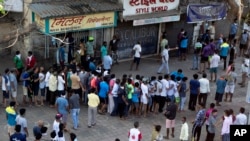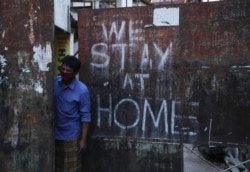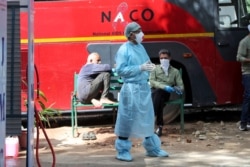India's six-week coronavirus lockdown, which was supposed to end on Monday, has been extended for another two weeks, with a few relaxations such as construction resuming and self-employed people returning to work in New Delhi.
Here's a look at what India has been able to achieve during the lockdown of its 1.3 billion people, and what it hasn't:
World's largest lockdown
Prime Minister Narendra Modi locked India down on March 24, when the country had just 469 confirmed virus cases.
In mid-April, Modi extended the lockdown for two weeks. Then on Friday, it was extended for two more weeks, but with some relaxations.
The government has identified three zones: “red,” or areas that have been coronavirus hotspots, “orange,” where some cases have been found, and “green,” or low-risk areas. Stricter measures will continue in red and orange zones, while some movement of people and most economic activities will be allowed in green zones.
Although the number of red zones has dipped since the lockdown started, the number of green zones has also declined. Most of India's major cities, including New Delhi and Mumbai, remain red zones.
Locking down the country's 1.3 billion people has cost millions of jobs and upended lives, especially of India's poor.
But limited interactions between people did slow the contagion, pushing the peak into the future and buying India ``time to prepare,'' said Ramanan Laxminarayan, an epidemiologist and economist who directs the Center for Disease Dynamics, Economics & Policy in Washington, D.C.
India has avoided a major catastrophe, confirming about 42,500 virus cases, 11,706 recoveries and 1,373 deaths. Still, a lack of aggressive testing worries experts who warn that the virus has yet to peak.
Preparing hospitals
India has designated more than 600 hospitals for COVID-19 patients only, comprising about 100,000 isolation beds and around 12,000 intensive care unit beds. It also has trained more than a million doctors and 1.7 million nurses to treat patients, according to government data.
Authorities have tried to ensure that only those who are very sick with the virus go to the designated hospitals. But this separation, aimed at preventing viral outbreaks in hospitals, hasn't always been successful.
It wasn't until Friday that the government said it would provide all health workers with personal protective equipment, or PPE. But several non-COVID-19 hospitals in large cities like Mumbai and New Delhi have already reported outbreaks. Experts suspect the outbreaks were caused by patients who were unaware they had the virus.
Combined with the government's reluctance to acknowledge that India had reached the stage of community transmission, this left the health care system unprotected, said Dr. T. Sundararaman, a community medicine expert.
“Even if a patient comes in with a fever, it will not be assumed to be COVID-19,” he said. “Unless it's too late."
Producing medical supplies
Faced with an unprecedented global demand for the same medical supplies, India has upped its capacity to manufacture ventilators, oxygen cylinders and PPE.
India is now building up a stockpile of 80,000 ventilators that it hopes will cover the 75,000 patients it expects will need them in the coming weeks, said PD Vaghela, secretary of the government's pharmaceuticals department.
Vaghela said India had almost no domestic manufacturing of PPE before the pandemic.
‘Now we have 111 indigenous manufacturers,’ he said, adding that these domestic companies are expected to provide 70% of the 20 million pieces of PPE needed.
Shortfalls in testing
India's testing criteria remain restricted outside of hotspots, where those with minor symptoms, like a runny nose or cough, aren't being tested. But it has increased testing, with 70,000 samples tested daily.
Still, India “needs to be scaling up for a lot more,” said Dr. Ashish Jha, the director of Harvard's Global Health Institute. He pointed out that while the lockdown had stopped the virus from spreading as quickly as it has in some countries, that doesn't mean that it won't spread faster when restrictions are lifted.
India's low testing rate is at least partly due to the unavailability of testing kits. After claiming that the rapid antibody tests it got from China were faulty, India awaited the arrival of 2.1 million standard testing kits, mostly from international companies. Officials said the country will need 3.5 million kits.
India's health ministry has denied that it is under-testing. But Jha warned that India can't afford to test in areas only after outbreaks are discovered.
“If they could freeze the world in time and not ever unlock and stay locked down forever, then no, you'll not need to scale up testing anymore,” he said. “But obviously that's not possible.”









